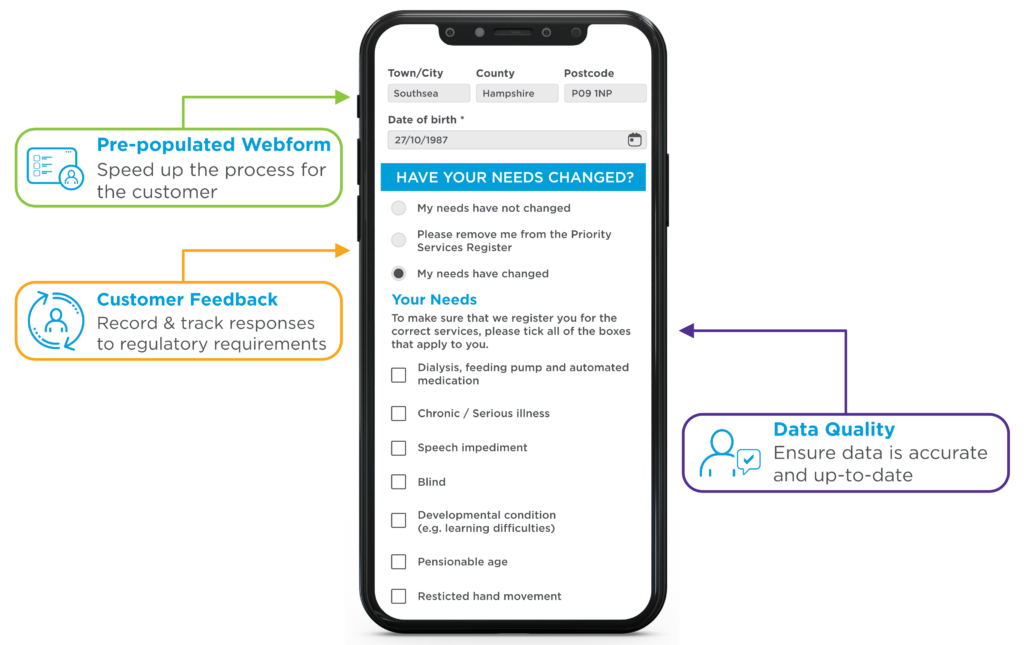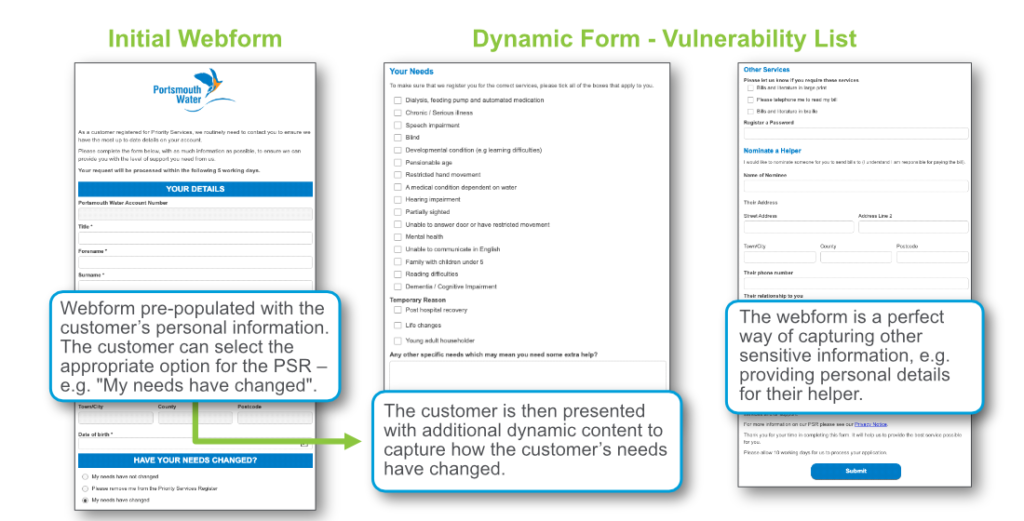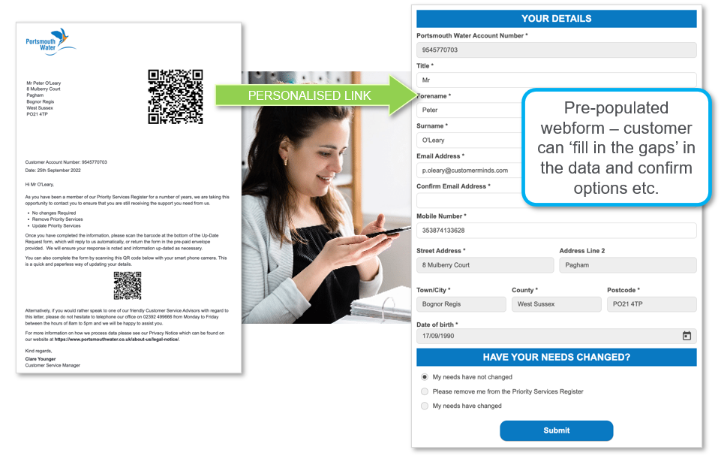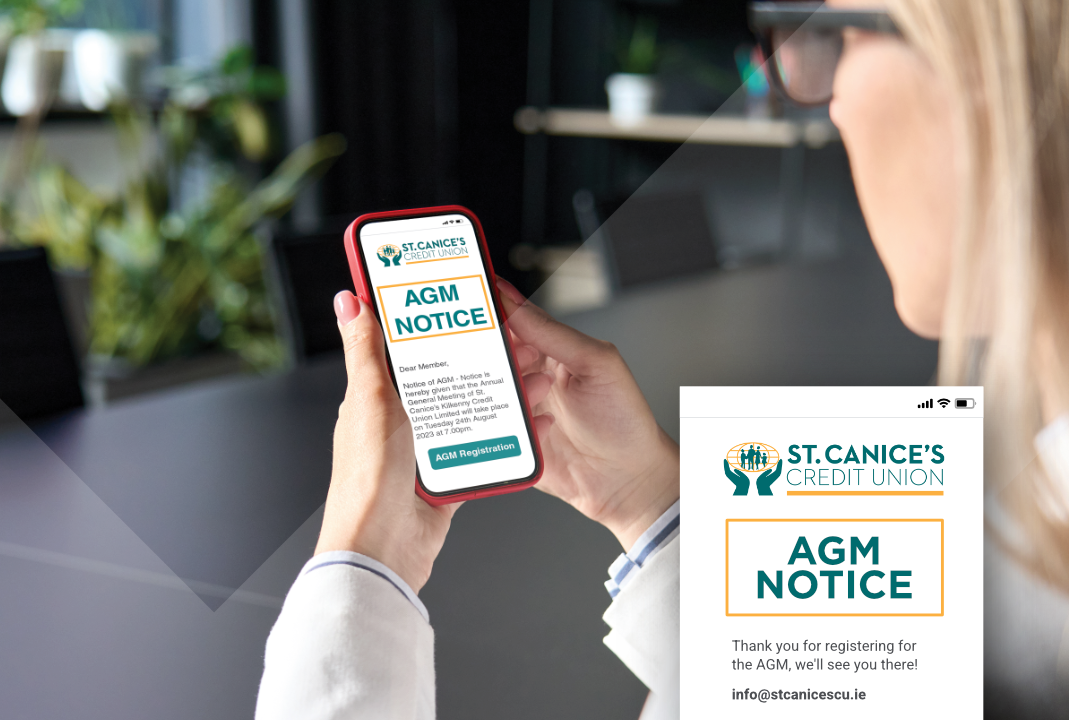Engaging Vulnerable Customers at Portsmouth Water

Portsmouth Water has been supplying water to the city of Portsmouth and the surrounding area since 1857 and serves a domestic population exceeding 698,000, as well as many important industries, large defence establishments and varied commercial businesses.
The company has a proud record of maintaining high standards of customer service whilst having the lowest water supply charges in England and Wales. As part of an ongoing focus on supporting its most vulnerable customers, Portsmouth Water was looking to digitise the process of collecting up-to-date information relating to the Priority Service Register.
Data Capture Form for Priority Service Register

Business Challenge
Portsmouth Water were looking to develop a digital “self-serve” customer journey to customers on their Priority Service Register (PSR) to ensure that their specific needs were understood and accurately recorded.
“We recognise the importance of maintaining up-to-date information for customers on our Priority Service Register as this ensures we provide the right support to customers at the right time. Ofwat also made this area a focus by having a specific performance commitment for water companies in this Business Planning Period (2020-2025). This challenged water companies to achieve a minimal engagement level with customers.
Matt Hamilton, Chief Customer Officer at Portsmouth Water
We were conscious we needed to partner with an organisation that would help us maintain our exceptional service to customers, whilst achieving the performance commitment in an efficient and automated way.”
Ofwat’s requirements around the Priority Service Register (PSR) performance commitment required that each company met the following key objectives:
- Attempt to contact 90% of households that are currently on the PSR every two years
- Achieve actual contact with 35% of the households that are on the PSR every two years
The Solution
In order for Portsmouth Water to reach the required number of contacts, their communications needed to be branded clearly, and personalised to each of their customers. The communications also needed to be digital-first, with printed materials as a fall-back option, rather than the other way round, as may have been the norm previously.
Using the Which50 platform, CustomerMinds created an automated Email & SMS journey, allowing Portsmouth Water to include multiple touchpoints, and contact as many customers as possible with minimal manual effort. On Day 1 of the campaign, an Email or SMS was sent to each customer. Each communications was fully branded and personalised, and included a link to a webform where the customer could input/update their details as necessary, or perhaps remove themselves from the Priority Service Register if they no longer needed support from Portsmouth Water.
A week later, a Follow-up Email & SMS were automatically sent to any customer who hadn’t yet engaged with the initial communications. And a week after that, another reminder was sent, in order to capture as much engagement as possible.
Digital Journey ‘Flow’ (Email & SMS)

The PSR webform is where the customer responses were recorded, and Which50 makes it very easy for the customer to complete and submit their details. The webform was pre-populated with any customer details that Portsmouth Water already had on file. The customer could review and change any of these if necessary. If their needs had changed since they were last contacted, selecting that option brought them to the next page where they could elaborate on their needs. The webform was designed to be mobile-responsive which meant that it could be easily filled out by the customer on their phone.

As for the customers who didn’t respond to the Emails or SMS, or those who didn’t have an email address, a physical letter was sent to their home address. These letters were generated within Which50 as a batch of PDF files which were then sent to Portsmouth Water’s existing print partner. These letters included a unique QR code for each customer, also generated by Which50, and when the customer scanned this QR code with a phone camera they were taken directly to their personalised webform, as if they had visited the link via an Email or an SMS.

Which50 collected all the traffic from any QR code scanning, and of course collected all the submissions of the webform. Detailed Reporting was available for each of the communications, with stats including the exact customers who opened and read the emails, or clicked the links across all of the different channels – including the ‘non-digital’ printed letters with the QR code! These figures were then viewed and exported for Portsmouth Water to share internally and with the regulator as required. As you’ll see in the Results section below, the campaign was a huge success for Portsmouth Water and helped them to achieve and surpass the targets set by Ofwat in a fraction of the time and cost required for the traditional methods of customer communication.
The Results
- 95% of customers were reached, which surpassed the goal of 90% reach.
- From that 95% of customers reached, 40% of them engaged with the communications, again surpassing the desired goal of 35%.
- When industry standards of engagement average 20%, and especially with action required such as a webform to fill in, this engagement level is quite an achievement.

Key Takeaways
- Increased engagement: Pro-active digital engagements resulted in increased engagement resulting in regulator commitment being achieved.
- Removed lengthy calls from the call centre: Customers who need to update the needs or confirm their needs have not changed are resource heavy for the call centre – removed 4,000+ calls from the call-centre during campaign.
- Delivered automation: Campaign delivered automation mitigating the need for additional people to process responses from the Campaign – reduced campaign costs by £40,000.
- Meeting customer needs: Customer needs and details updated improving our ability to meet customer needs during normal interactions but also if a no water event occurs.
If you would like to learn more about how the Which50 customer experience (CX) management platform can help utilities companies with digital transformation, please reach out to us below and we will get back to you as soon as we can.
 LOG IN
LOG IN